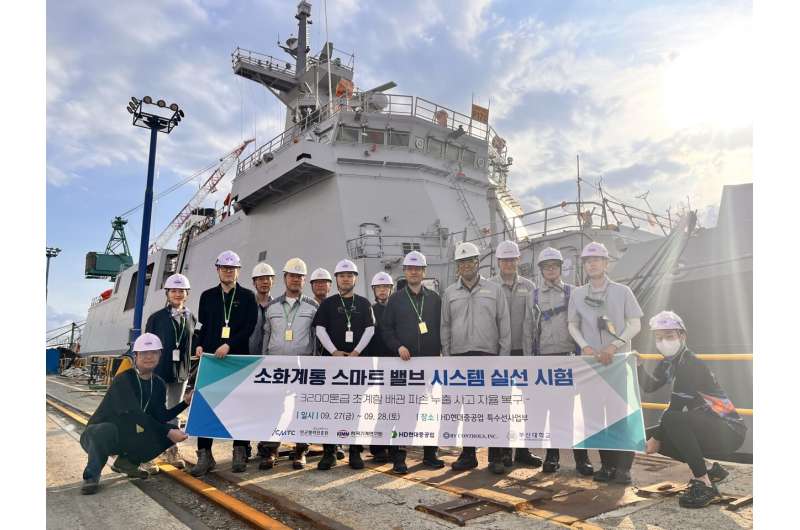
October 17, 2024 by National Research Council of Science and Technology
Collected at: https://techxplore.com/news/2024-10-autonomous-disaster-response-technology-successfully.html
An innovative technology for autonomously responding, without crew intervention, to ruptures to the pipes within the fire extinguishing system of vessels has been successfully verified for the first time in Korea. This technology is expected to be applied to various naval vessels such as next-generation destroyers and mine countermeasure vessels, helping to address the issue of crew shortages due to the demographic cliff and contributing to enhanced survivability.
The research team led by Principal Researcher Byungchang Jung of the Virtual Engineering Research Center of the Virtual Engineering Platform Research Division of the Korea Institute of Machinery and Materials (KIMM) has developed a “smart valve system” capable of autonomously and promptly responding to incidents within 60 seconds from the occurrence thereof, and successfully carried out the performance verification of this system on a 3,200-ton vessel currently being constructed by HD Hyundai Heavy Industries.
The “smart valve system” developed by the KIMM’s research team can help to solve the problems caused by crew vacancies resulting from population decline and contribute to the enhancement of the autonomy of vessel damage control, which refers to the series of actions taken by the crew of a vessel in situations such as fire or flooding on the ship. The crew ensures the survivability of the vessel and the crew by promptly responding to the disaster and preventing the damage from spreading further.
This system operates through the installation of multiple “smart valves” throughout the seawater fire extinguishing system of a vessel. To commercialize this technology, it is essential to secure data in various situations from vessels that are actually in operation. However, because there currently are no test ships in Korea, it is difficult to install privately developed technologies on ships and collect useful data.

To overcome these challenges, the KIMM’s research team installed a prototype of the smart valve system in the seawater fire extinguishing system of a ship that is currently being built by HD Hyundai Heavy Industries, and verified the system’s ability to autonomously respond to disasters by simulating a situation where pipes have been damaged.
The data obtained through the sea trial test is anticipated to play a significant role in accelerating the application of technologies developed by the private sector.
In particular, it is the first time for a privately developed technology to be verified on a vessel under construction. The KIMM’s latest research outcome is evaluated as a remarkable accomplishment achieved through collaboration among the industry, academia, and research institutions (the KIMM, HD Hyundai Heavy Industries, BY Controls, Inc., and Pusan National University).

Principal Researcher Byungchang Jung commented, “This newly developed technology allows for unmanned and intelligent operation and disaster control in piping systems in various industrial sectors such as petroleum, chemicals, power generation, and marine plants. It will also greatly contribute to future national defense and maritime mobility industries, including unmanned vessels.
“We will continue to collaborate with related organizations including shipbuilders and the Navy to ensure that this technology can be applied to naval vessels in the near future.”

Leave a Reply